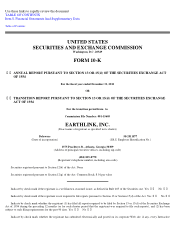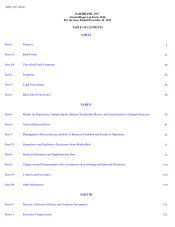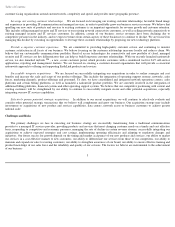Earthlink 2011 Annual Report Download - page 12
Download and view the complete annual report
Please find page 12 of the 2011 Earthlink annual report below. You can navigate through the pages in the report by either clicking on the pages listed below, or by using the keyword search tool below to find specific information within the annual report.
Table of Contents
Backbone. Our network backbone enables us to offer high-
quality wavelength, Ethernet, SONET, Internet access and virtual private
networking services. The packet-
switching portion of our network backbone is based upon Internet Protocol, which is a broadly deployed
standards-
based protocol that allows for the exchange of data between computer networks. The network infrastructure is built on our Wavelength
Division Multiplexing, or WDM, platform and core routers.
Competition
The communications industry is highly competitive, and we expect this competition to intensify. These markets are rapidly changing due to
industry consolidation, an evolving regulatory environment and the emergence of new technologies. We compete directly or indirectly with
ILECs, such as AT&T, CenturyLink, Inc. and Verizon Communications Inc.; CLECs, such as Level 3 Communications Inc., MegaPath, Inc.,
Windstream Corporation and XO Holdings Inc.; interexchange carriers, such as Sprint Nextel Corporation; wireless and satellite service
providers; cable service providers/multiple system operators (MSOs), such as Charter Communications, Inc., Comcast Corporation, Cox
Communications, Inc. and Time Warner Cable; and stand-
alone VoIP providers. We experience significant pricing and product competition
from AT&T and other incumbents that are the dominant providers of telecommunications services in our markets. We have reduced, and may be
required to further reduce, some or all of the prices we charge for our retail local, long distance and data services.
The managed IT services industry is also highly competitive. These markets are fragmented and evolving. Competitors range in size from
small, local independent firms to very large telecommunications companies, hardware manufacturers and system integrators. We compete
directly or indirectly with telecommunications companies such as AT&T, Verizon Communications Inc. and Level 3 Communications Inc.;
system integrators such as IBM, Hewlett-
Packard, Accenture and CSC; managed hosting and cloud providers such as Equinix, Inc., Internap
Network Services Corporation, Rackspace Hosting, Inc., Terremark Worldwide, Inc. and Web.com Group, Inc.; and managed security
companies such as Perimeter eSecurity and Secure Works.
Competition could adversely impact us in several ways, including (i) the loss of customers and resulting revenue, (ii) the possibility of
customers reducing their usage of our services or shifting to less profitable services, (iii) reduced traffic on our networks, (iv) our need to expend
substantial time or money on new capital improvement projects, (v) our need to lower prices or increase marketing expenses to remain
competitive, and (vi) our inability to diversify by successfully offering new products or services.
We believe the primary competitive factors in the communications and managed services industries include price, availability, reliability of
service, network security, variety of service offerings, quality of service and reputation of the service provider. While we believe our business
services compete favorably based on some of these factors, we are at a competitive disadvantage with respect to certain of our competitors.
Many of our current and potential competitors have greater market presence, engineering, technical and marketing capabilities and financial,
personnel and other resources substantially greater than ours; own larger and more diverse networks; are subject to less regulation; or have
substantially stronger brand names. In addition, industry consolidation has resulted in larger competitors that have greater economies of scale.
Consequently, these competitors may be better equipped to charge lower prices for their products and services, to provide more attractive
offerings, to develop and expand their communications and network infrastructures more quickly, to adapt more swiftly to new or emerging
technologies and changes in customer requirements, to increase prices that we pay for wholesale inputs to our services and to devote greater
resources to the marketing and sale of their products and services.
7
























